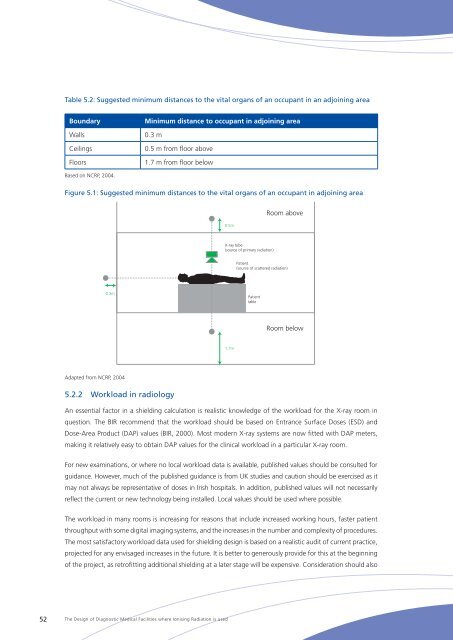The Design of Diagnostic Medical Facilities where ... - ResearchGate
The Design of Diagnostic Medical Facilities where ... - ResearchGate
The Design of Diagnostic Medical Facilities where ... - ResearchGate
You also want an ePaper? Increase the reach of your titles
YUMPU automatically turns print PDFs into web optimized ePapers that Google loves.
Table 5.2: Suggested minimum distances to the vital organs <strong>of</strong> an occupant in an adjoining area<br />
Boundary<br />
Walls<br />
Ceilings<br />
Floors<br />
Minimum distance to occupant in adjoining area<br />
0.3 m<br />
0.5 m from floor above<br />
1.7 m from floor below<br />
Based on NCRP, 2004.<br />
Figure 5.1: Suggested minimum distances to the vital organs <strong>of</strong> an occupant in adjoining area<br />
0.5m<br />
Room above<br />
X-ray tube<br />
(source <strong>of</strong> primary radiation)<br />
Patient<br />
(source <strong>of</strong> scattered radiation)<br />
0.3m<br />
Patient<br />
table<br />
Room below<br />
1.7m<br />
Adapted from NCRP, 2004<br />
5.2.2 Workload in radiology<br />
An essential factor in a shielding calculation is realistic knowledge <strong>of</strong> the workload for the X‐ray room in<br />
question. <strong>The</strong> BIR recommend that the workload should be based on Entrance Surface Doses (ESD) and<br />
Dose-Area Product (DAP) values (BIR, 2000). Most modern X‐ray systems are now fitted with DAP meters,<br />
making it relatively easy to obtain DAP values for the clinical workload in a particular X‐ray room.<br />
For new examinations, or <strong>where</strong> no local workload data is available, published values should be consulted for<br />
guidance. However, much <strong>of</strong> the published guidance is from UK studies and caution should be exercised as it<br />
may not always be representative <strong>of</strong> doses in Irish hospitals. In addition, published values will not necessarily<br />
reflect the current or new technology being installed. Local values should be used <strong>where</strong> possible.<br />
<strong>The</strong> workload in many rooms is increasing for reasons that include increased working hours, faster patient<br />
throughput with some digital imaging systems, and the increases in the number and complexity <strong>of</strong> procedures.<br />
<strong>The</strong> most satisfactory workload data used for shielding design is based on a realistic audit <strong>of</strong> current practice,<br />
projected for any envisaged increases in the future. It is better to generously provide for this at the beginning<br />
<strong>of</strong> the project, as retr<strong>of</strong>itting additional shielding at a later stage will be expensive. Consideration should also<br />
52<br />
<strong>The</strong> <strong>Design</strong> <strong>of</strong> <strong>Diagnostic</strong> <strong>Medical</strong> <strong>Facilities</strong> <strong>where</strong> Ionising Radiation is used
















